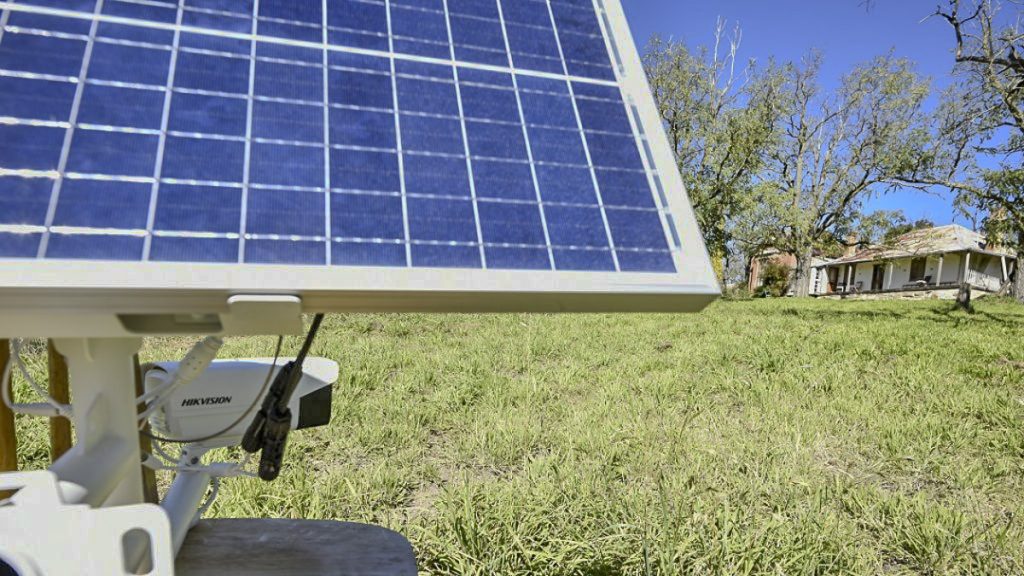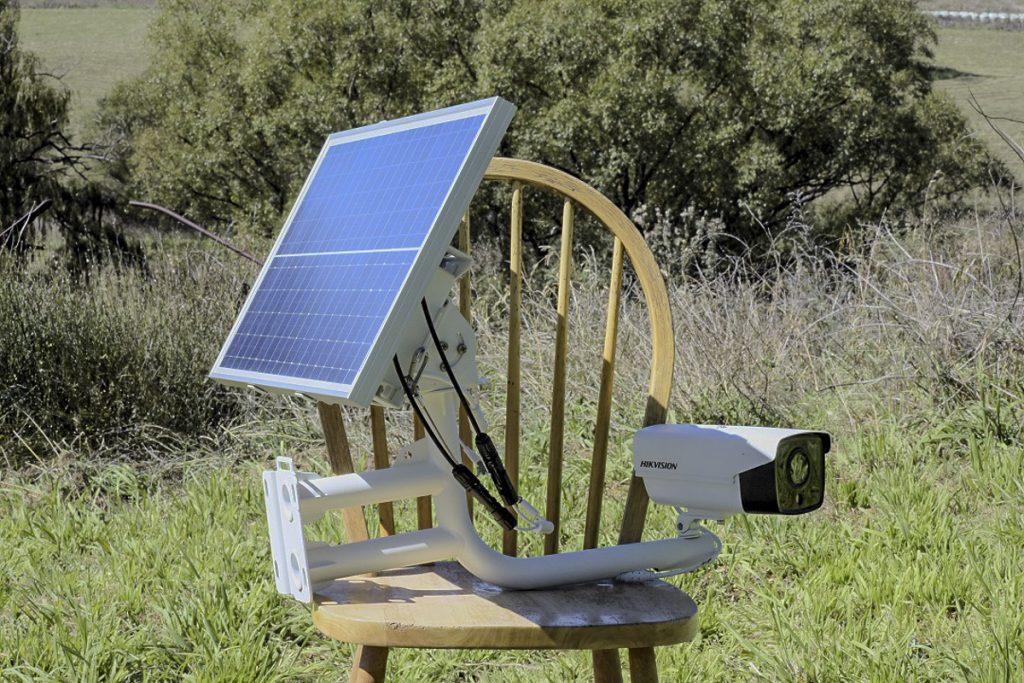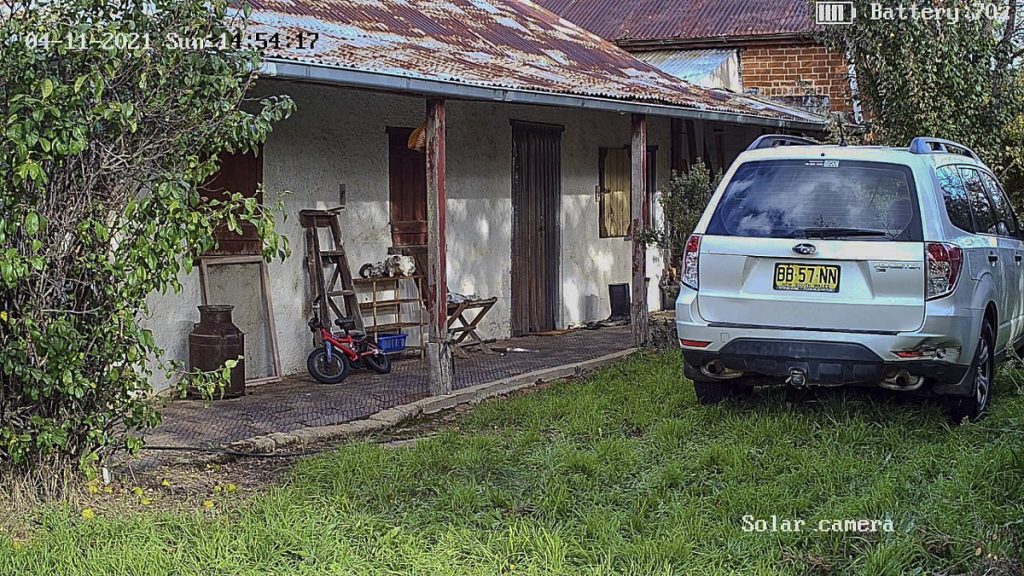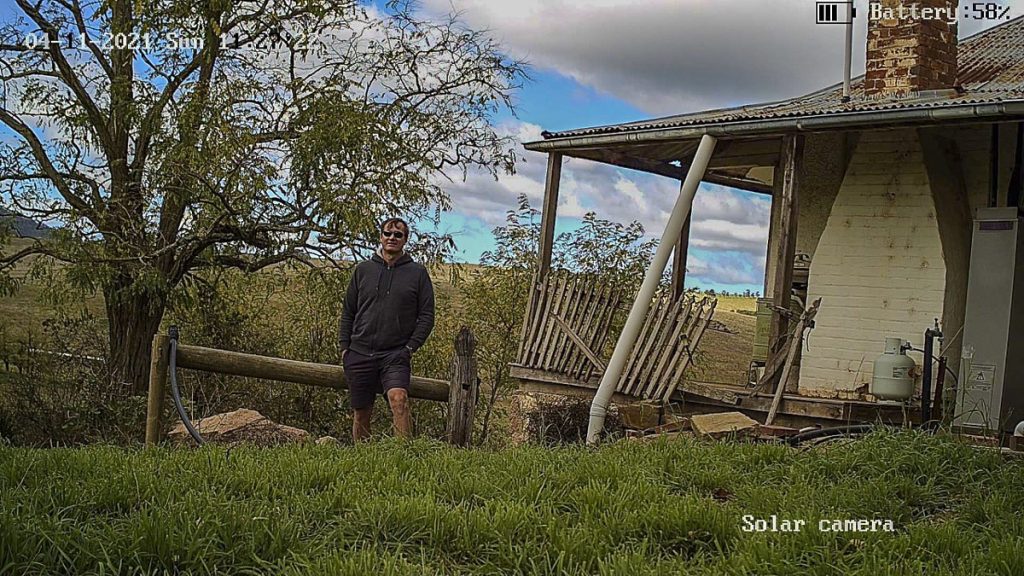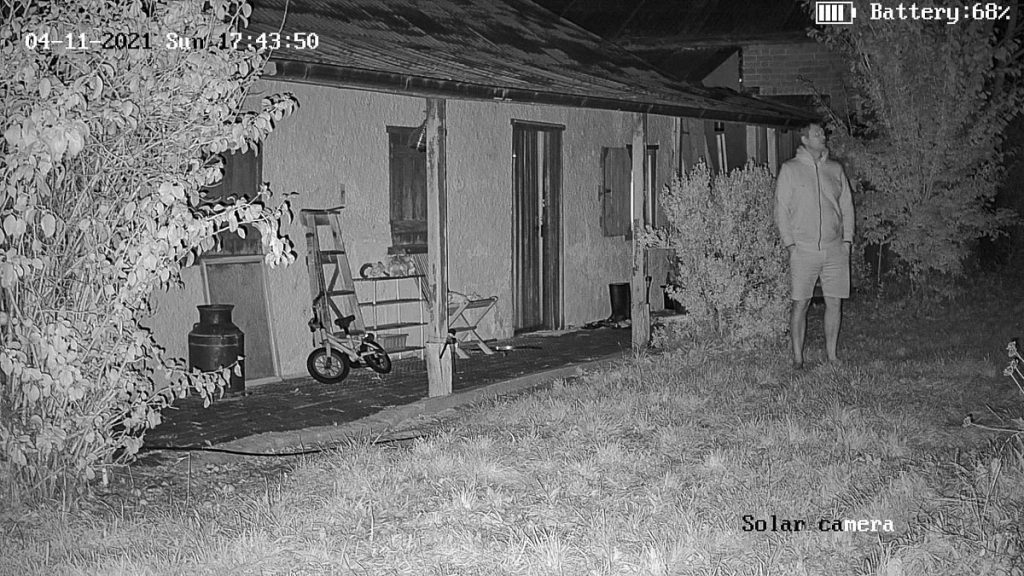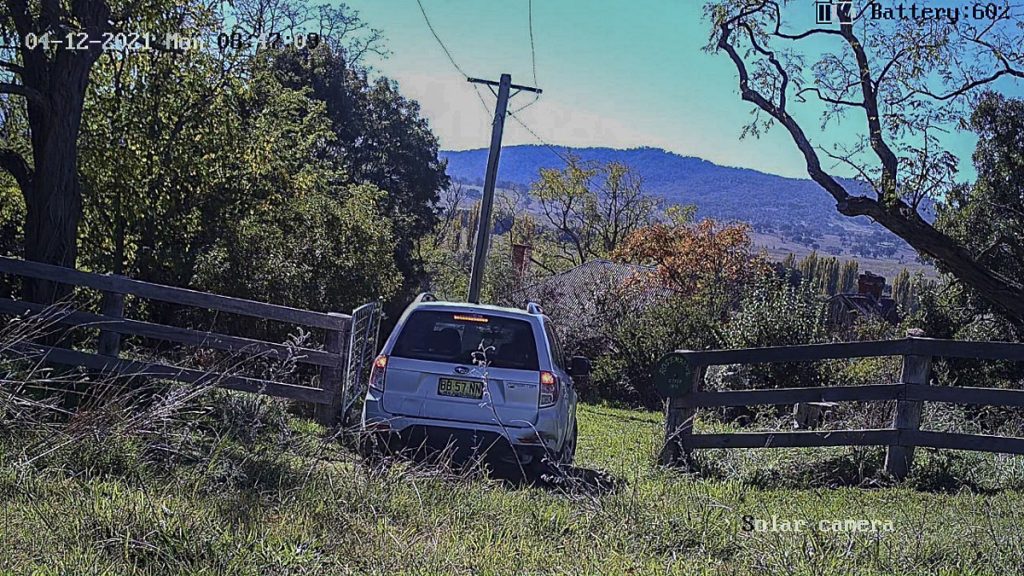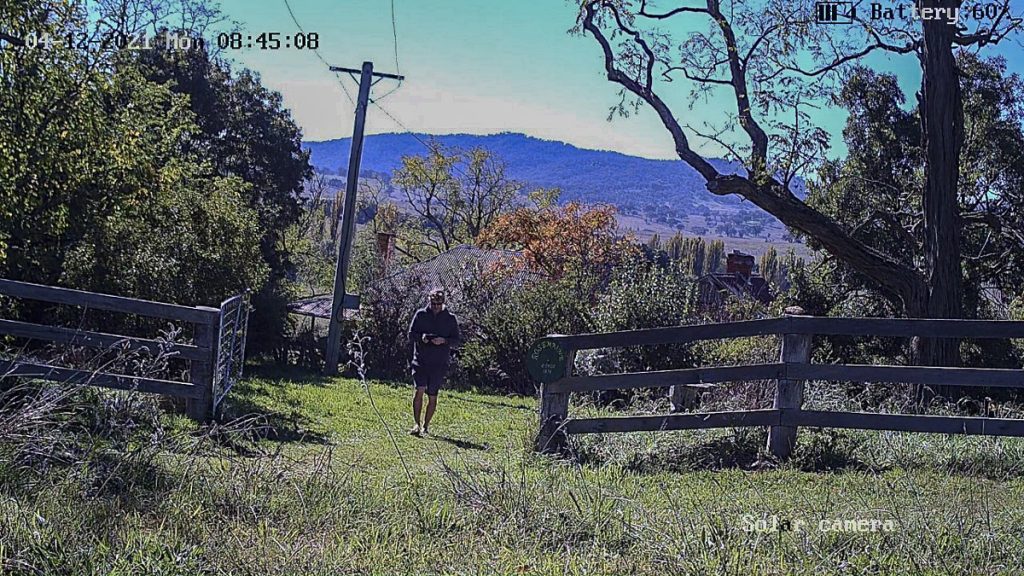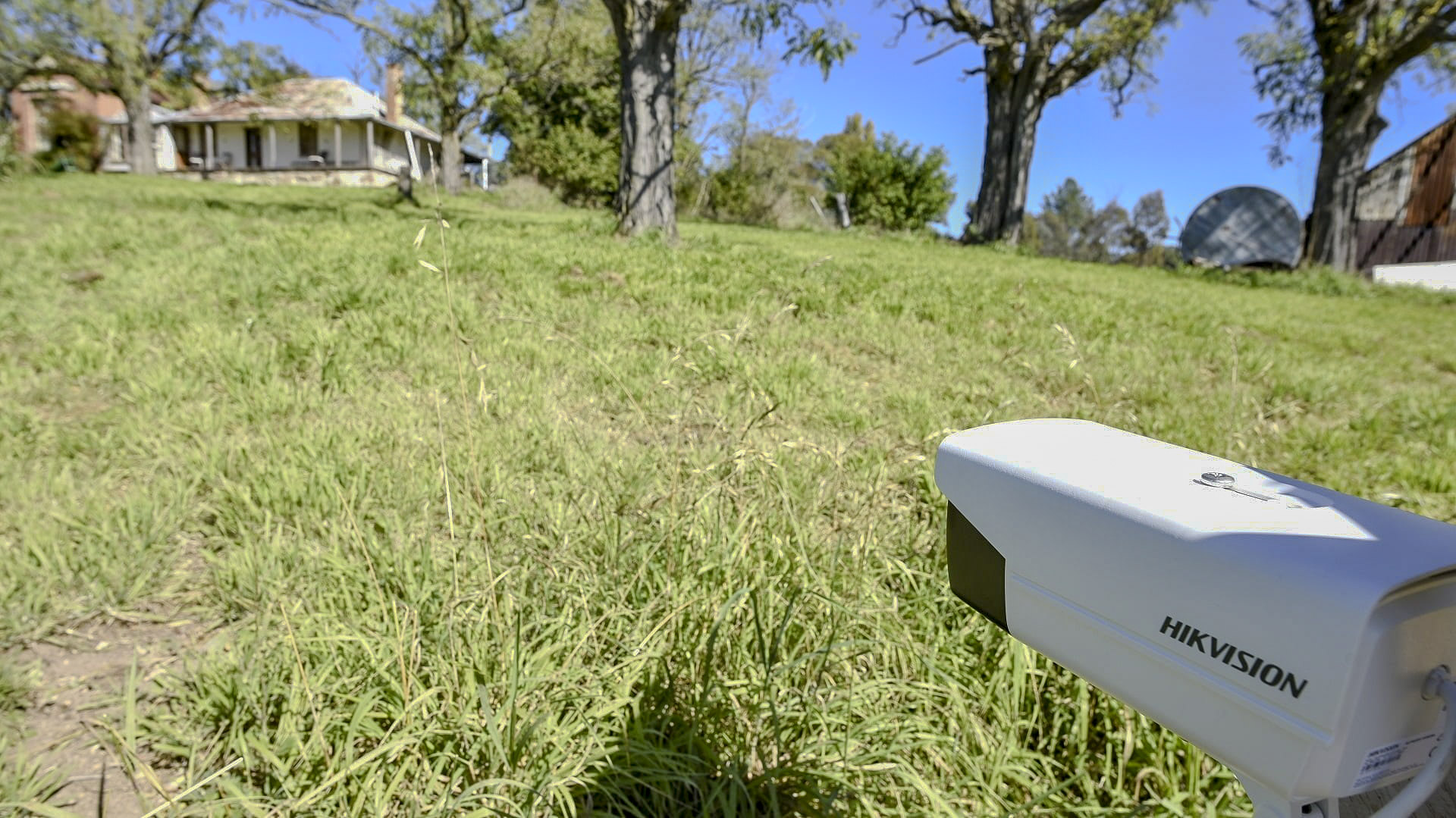Hikvision DS-2XS6A25GO Solar Bullet Camera Review – This amazing device is a solar-powered 1080p bullet camera system with a ½.8-inch progressive scan CMOS sensor with minimum scene illumination of 0.004 in colour at F1.4 with AGC on, or 0.002 lux or 0 lux (with IR on) in monochrome.
The key to this camera is a battery pack that allows the unit to operate for 7 days if the 20Ah lithium battery is fully charged by the 40W photovoltaic panel.
Contents
Introduction
Released by Hikvision a few years ago, the day/night DS-2XS6A25GO bullet is available with the option of a fixed 2.8, 4, or 8 mm fixed lens – I have the 4 mm version and for this rural application, that focal length is right. There are times I wish for a wider angle of view close to the house, but when monitoring gates, driveways, and throughways from a moderate distance on the property, a longer focal length congregates pixels in a pleasing way.
Central to this camera’s operation is a battery pack that allows the unit to operate for 7 cloudy days if the 20Ah lithium battery is fully charged by the system’s 40W photovoltaic panel. I discovered less than 5 hours sun is enough to top the battery up from 50 to 100 per cent. This means it’s unlikely you’ll ever lose power if the solar array is sited more or less optimally for the position of the sun in the sky. On the topic of the array, it adjusts across 180 degrees in a fixed arc.
General Features – DS-2XS6A25GO Solar Bullet Camera Review
General features of this camera system include 120dB of WDR, 52dB signal-to-noise ratio, integrated battery display, battery high-low temperature protection, charge-discharge protection, low-battery sleep protection and remote wakeup, LTE-TDD/LTE-FDD/WCDMA/GSM 4G wireless network transmission, support for Micro SIM cards, and water and dust resistance to IP67, which is immersion. Operating range is -30 to 60C, which is strong.
The 4 mm lens has a moderately fast aperture of F1.4, delivers a horizontal field of view of 86 degrees and a vertical field of view of 46 degrees. The camera’s shutter speed is adjustable from 1s to 1/100,000s There’s 850 nm of smart IR support with a range of 30m, 3 video streams, with main offering H.265+, H.265, H.264 plus and H.264; a sub stream of H.265, H.264 or MJPEG; and a third stream of H.265 or H.264. Bit rate range is 32Kbps to 8Mbps, there’s CBR/VBR bit rate control, scalable video coding (SVC), and 4 fixed regions of interest (ROI) for each stream.
Image Enhancement
Image enhancement functionality includes BLC, HLC, 3D DNR, and defog, while image settings include rotate mode, saturation, brightness, contrast, sharpness, gain, and white balance, all these adjustable in client software or web browser. Comms include RJ45, RS-485 (half-duplex) and integrated 4G. Onboard storage is via a 256 GB MicroSD and recordings can be uploaded to FTP, NAS or the memory card. If you’re using Hik-Connect app, as I am, then images are uploaded to the cloud and accessible from an authorised smart device from anywhere.
Surveillance
A standalone surveillance solution like this, which just begs to be used in locations you’d never dream of installing wired cameras, needs analytics to automate recording functions. With the DS-2XS6A25GO you have motion detection, video tampering alarm, exception (network disconnected, IP address conflict, illegal login, HDD full, HDD error), smart events like line crossing detection with up to 4 configurable regions, region entrance detection with 4 configurable regions, region exiting detection with 4 regions for config and unattended baggage and object detection in 4 regions. There’s also scene change detection.
Other features of the camera include 6 channels of simultaneous live view accessible by 32 users organised in 3 levels, open API, open interfaces, including PROFILE S, PROFILE G, PROFILE T; there’s ISAPI, SDK, and Ehome, and Hikvision’s laundry list of supported protocols, including TCP/IP, ICMP, HTTP, HTTPS, FTP, SFTP, DHCP, DNS, DDNS, RTP, RTSP, RTCP, NTP, UPnP, SMTP, SNMP, IGMP, 802.1X, QoS, IPv6, UDP, Bonjour and SSL/TLS. There’s also anti-flicker, 3 stream heartbeat, mirror, flash log, password reset via e-mail, pixel counter, software reset and remote firmware updates.
Security is also comprehensive and includes password protection, complicated password, HTTPS encryption, 802.1X authentication (EAP-TLS, EAP-LEAP, EAP-MD5), watermark, IP address filter, basic and digest authentication for HTTP/HTTPS, WSSE and digest authentication for ONVI, RTP/RTSP OVER HTTPS, Control timeout settings and TLS 1.2. Client options include iVMS-4200, Hik-Connect and Hik-Central and there’s a plug-in for live view. Mobile communications include 4G frequencies in the LTE-TDD band at 38/40/41, LTE-FDD bands of 1/3/5/7/8/20/28, and WCDMA bands of 1/5/8 and GSM in bands 3/5/8.
Power
12V DC power consumption is modest – it’s 1.76W excluding 4G comms at 50 per cent IR illumination. According to Hikvision, the solar requirement for constant operation is 1.77 hours of direct sunlight on the panel every 24 hours.
The power interface is a 5.5 mm plug and for external applications you’d need to weatherproof this connection by installing it inside a $10 waterproof junction box – a trivial customisation. Camera system dimensions are 760 mm x 732.6 mm x 586.9 mm and the weight is just under 13 kg. On the battery side, the charge voltage is 12.6V – that’s less than an LA or AGM battery because this is Li-Ion, and battery life is quoted at 800 cycles, but is likely to be considerably more than that.
Test Driving the Hikvision DS-2XS6A25GO
First impressions with SEN’s version, which sports the longer 4 mm fixed focal length, were pleasing, with strong performance in my scenes. Something to note first up is that our test was conducted on a remote rural property in the presence of 2 bars of 4G, dropping at times to 1 bar and occasional network loss.
This skimpy network support meant we kept the camera in SD more often than we would have in another location, where HD would have been the order of the day. Because we are at an altitude of 800 metres, there were also times cloud forms got between the camera and our nearest 4G tower, which is faintly visible on the far horizon, and these impacted further on our link, causing drop-outs.
I should point out that the unit is relatively heavy at 13 kg and relatively awkward to handle for one person in terms of installation using the supplied stainless straps. In my application with Northerly sun and a Southerly scene, having the solar panel tilted to the same side as the bracket (it tilts through 180 degrees side-to-side) meant pole or tree-mounting would block the solar array from the Northerly sun.
Instead, I found myself positioning the camera on a water tank, a tree stump, a grassy bank, a kitchen chair, an outside table (in my application the perfect solution would be a 2m pole with the camera mounted a few inches from the top). All these organic mounting points highlighted just what a flexible CCTV solution Hikvision has built. You can put the DS-2XS6A25GO solar bullet anywhere you like that’s stable and which offers a field of view. You can move it any time you like to meet unfolding threats or monitoring requirements.
In my case, those locations included approaches to the house, the front gate, the front yard between house and garage – on a whim I connected to the camera while it was sitting in the back of the car. Battery performance was good, too. Even with lower Autumn sun the system charged quickly and having the battery percentage front and centre on the app screen meant I never needed to wonder about battery life remaining or consumption. Quickly I realised the system wasn’t power hungry, even with me using it constantly.
You drive the unit via the Hik-Connect app, which I found very easy to use. The app interface is simple, with a couple of tools and icons and an easy one-press snapshot function. In fact, I drove the entire camera test using my phone. I had an iPad to hand, but I was happy with a standard iPhone and Hik-Connect. This made the camera effortless to interact with because my phone was always in my hand.
Setup
Setup was easy, too – you load the app, scan the camera mounted QR code and away you go. But what really shone through was the flexibility of this solution in the hand. Tap the app, and away you go. In Hik-Connect there’s movement detection and other AI stuff to play with, making monitoring automatic and limiting storage requirements. And if you have movement detection set up, each time you get movement you get a notification from which you click through to view the event image and/or take a look at the live footage.
I’ve made a thing about the flexibility of location with this camera – you could lean it against a wall and power it up and away it would go – but the flexibility doesn’t end there. You can also connect to it anywhere you like – for me that included while lying in front of the fire, while parked outside a supermarket 20km away, while standing beside the unit checking I was happy with the angle of view and while lying in bed at 2am wondering about a weird tapping noise at the front door (it was the fly strip blowing in the wind).
Low Light Performance
I should reiterate how good the night performance was – it’s an excellent image with auto IR, which activated relatively early in the evening. Yes, I know it’s assisted performance, but there are plenty of cameras that do badly with IR, and this isn’t one of them. Night images are high contrast with surprising sharpness and high levels of detail from the organic surfaces of the wattle and daub walls of the house, suggesting excellence with tone. The IR array has a good spread and plenty of penetration – in fact that 30 metres of IR range pushes past the camera’s optimum night-time depth of field. In my application best performance was from the lens to about 8-12 metres.
After the night test was complete, we went through the motion detection images from the evening, fingers crossed in hopes we might see the last mainland Thylacine, or even just a wallaby, but the only thing moving in the camera’s angle of view was that flailing fly strip. The process of scrolling through images saved by motion events in the app was as simple as you’d expect it to be.
High Lux Performance
In terms of daytime performance, the 2MP bullet impressed with good colour rendition, decent work against backlight and great handling of variable scenes. Hikvision makes a good camera engine and even in relatively modest bullet form like this, performance was dependable across a range of conditions. The first day of the test there were periods of bright sunlight and periods of moderate shadow and the camera did well – you can see how rich the colour rendition is in the images – the red brick is 10m from the lens. There’s good sharpness in these scenes and you can see the hyperfocal distance is within half a metre – the grass stems are right in front of the lens.
I felt performance popped more in full sun, with excellent colours and high levels of detail, thanks to a strength in tone. All this is no doubt enhanced by the simplicity of the fixed lens equation. As light levels fell, the colour temperature drifted towards the warmer end and colour rendition fell away. Something I did note in a couple of high contrast scenes were widespread chromatic aberrations, but they were not impacting on my ability to get faces, plates and other details. At the same time, there was no barrel distortion from the 4mm lens.
Recognition and Identification
Recognition and identification were strong, and you have to bear in mind that I did not have the camera at full resolution the entire time, as the 4G network in my corner of the country is merely passable and is always made worse by intervening cloud cover, showers of rain and atmospheric variations. With a more robust network, the camera would have been able to run full out the whole time. That performance would be available anywhere around a regional town, or in any metro area, or even just closer than we are to a 4G tower.
The DORI numbers with the 4 mm lens are detected at 53 metres, observe at 21 metres, recognise at 11 metres and identify at 5 metres. In my opinion, these numbers aren’t accurate – I could identify at over 10 metres and recognise past 15 metres. I felt observation at 21 metres was accurate, but that detection at 53 metres might be a stretch – things get soft that far in.
Generally, I was impressed with this camera’s ability to get faces and useful plates at 10–12 metres, even when operating at lower than full resolution. The camera’s ability to jag plates and faces mid-scene was appreciated in this application. I was getting plates at 15 metres, useable faces at the same depth. On acreage, that ability is seriously valuable.
Performance against vehicles inside 10 metres was particularly strong. ID of vehicles going through gates was iron-clad and with movement detection set, you can view these images remotely should an event be triggered. I was able to view a vehicle at the gate from 200 metres away in the orchard, as well as check the gate from a nearby town while on a shopping trip.
For rural applications where regular thefts occur, the ability of this camera to deliver the goods is unquestionable. There’s none of the creation-story light flares and massive angles of view with zero depth of field and huge barrel distortions you typically get with the sorts of cameras used in compact standalone camera systems. At the same time, this camera is not a hugely expensive customised solution. It’s simple and functional, works out of the box and best of all, it performs impressively in the field.
Conclusions – DS-2XS6A25GO Solar Bullet Camera Review
Hikvision’s DS-2XS6A25GO solar bullet camera is an excellent solution. Thinking about it later, I came up with many potential applications, from farms, to light industrial, car yards, mobile cameras for large sites, and plenty more. It’s affordable, it’s hugely flexible, and it’s easy to manage via phone or tablet.
Camera performance is good, too. It’s not a Darkfighter X, but the camera does good work during the day and night performance, with IR impressed as well. For my application and for many of yours, this solar bullet will prove very capable, indeed. For any application that can’t be cabled, and which is subject to evolving threats, the DS-2XS6A25GO is highly recommended.
What is Hik-Connect?

Hik-Connect Software, available on PC and mobile devices, has been designed to help households, small and medium-sized businesses (SMB) and multi-site enterprises effectively operate and manage security devices remotely.
The power of 24/7 monitoring, intrusion alarms, video intercom, access control and cloud-based attendance — all combined in one platform — keeps properties and business connected and protected every hour.
More can be read more about this by clicking Hik-Connect.
(DS-2XS6A25GO Solar Bullet Camera Review)
DS-2XS6A25GO Solar Bullet Camera Review
DS-2XS6A25GO Solar Bullet Camera Review DS-2XS6A25GO Solar Bullet Camera Review DS-2XS6A25GO Solar Bullet Camera Review DS-2XS6A25GO Solar Bullet Camera Review DS-2XS6A25GO Solar Bullet Camera Review DS-2XS6A25GO Solar Bullet Camera Review DS-2XS6A25GO Solar Bullet Camera Review DS-2XS6A25GO Solar Bullet Camera Review DS-2XS6A25GO Solar Bullet Camera Review DS-2XS6A25GO Solar Bullet Camera Review






